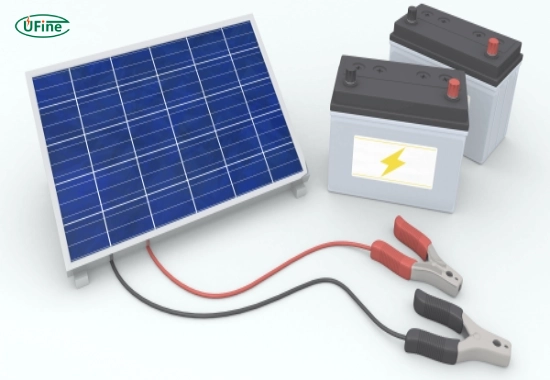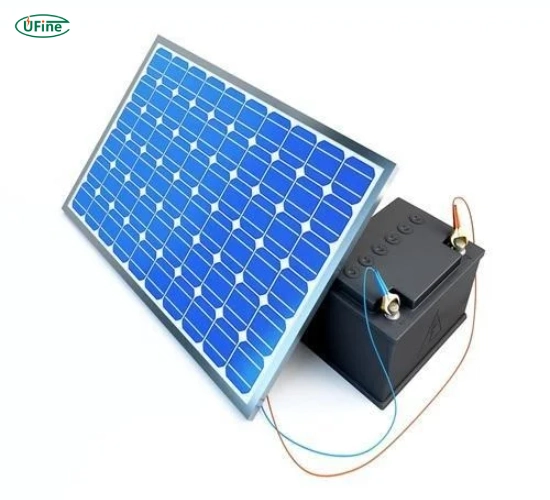The lightweight solar battery market is rapidly evolving as more people seek sustainable energy solutions. Manufacturers design these batteries to efficiently store energy generated from solar panels, making them essential for anyone looking to harness solar power effectively. This comprehensive guide will delve into the various aspects of lightweight solar batteries, including their importance, types, features, and top brands available in the market.
Part 1. What is a lightweight solar battery?
Engineers precisely design a lightweight solar battery to store energy generated from solar panels while ensuring it remains portable and easy to handle. Unlike traditional batteries that can be heavy, these batteries are designed for versatility, making them ideal for various applications such as camping, RV travel, and residential backup power systems.
Key Benefits:
- Portability: Their lightweight design allows easy transport and installation, perfect for outdoor activities or temporary setups.
- Efficiency: These batteries maximize energy storage from solar panels, ensuring you have power when needed, even during peak demand hours.
- Versatility: Lightweight solar batteries are suitable for multiple applications, from off-grid living to emergency power supplies. They can adapt to various energy needs.
Part 2. Why are lightweight solar batteries essential?
Lightweight solar batteries play a vital role in optimizing the use of solar energy. By storing excess energy generated during sunny days, these batteries ensure backup power is available during cloudy or nighttime. This capability enhances energy independence and significantly reduces your reliance on grid electricity.
Advantages include:
- Energy Security: Provides reliable backup power during outages, ensuring that essential devices remain operational.
- Cost Savings: Reduces reliance on traditional electricity sources, leading to lower utility bills over time.
- Environmental Impact: Supports sustainable energy practices by promoting the use of renewable resources, thereby reducing carbon footprints.
Part 3. How does a lightweight solar battery differ from a regular solar battery?
The primary difference between a lightweight solar battery and a regular solar battery lies in their design and intended use:
- Weight and Portability: Manufacturers specifically design lightweight solar batteries to be portable, making them easier to carry and install than regular batteries, which tend to be bulkier. This design makes them ideal for mobile applications like RVs or camping setups.
- Energy Density: Lightweight options often utilize advanced materials like lithium-ion technology, providing higher energy density in a smaller package than traditional lead-acid batteries. This means you get more power in less weight.
- Applications: While regular batteries may be suited for stationary installations or larger systems, lightweight batteries are ideal for mobile applications where space and weight are critical factors.
- Charging Efficiency: Lightweight batteries generally offer faster charging times due to their advanced chemistry. This enables users to recharge them quickly during sunny days or while driving.
Part 4. Types of lightweight solar batteries
When selecting a lightweight solar battery, it’s essential to understand the different types available:
- Lithium-ion Batteries: Lithium-ion batteries, known for their high energy density and longevity, are lightweight and efficient. They typically last longer than other types—often exceeding 10 years—and require less maintenance. Their ability to handle deep discharges without damage makes them particularly appealing for off-grid applications.
- Lead-Acid Batteries: While heavier than lithium-ion options, lead-acid batteries are often more affordable. They come in two main types—flooded and sealed (AGM or gel). Flooded lead-acid batteries require regular maintenance and ventilation. Still, they can be cost-effective for stationary applications where weight is less of a concern.
- Gel Batteries: A subtype of lead-acid batteries, gel batteries are sealed and can be mounted anywhere. They perform well in various temperatures but may not be as efficient as lithium-ion options. Their design minimizes the risk of spillage or leakage, making them safer for indoor use.
Part 5. How do you determine your power needs with a lightweight solar battery?
Before selecting a lightweight solar battery, assess your power requirements:
- Calculate Daily Energy Consumption: Add the wattage of all devices you plan to run on the battery. This will give you an estimate of how much energy you need daily.
- Consider Peak Usage Times: Identify when your energy demands are highest. For example, if you plan to run multiple devices simultaneously during the evening hours, factor this into your calculations.
- Factor in Battery Efficiency: Not all batteries store energy equally; consider the efficiency rating when calculating your needs. A higher efficiency rating means more usable energy from each charge cycle.
Part 6. Lightweight solar battery performance in different weather conditions
Understanding how a lightweight solar battery performs under various weather conditions is crucial for optimizing its use:
- Sunny Days: Lightweight solar batteries can charge quickly and efficiently on clear days with ample sunlight. The high energy density of lithium-ion options allows for rapid charging, ensuring you have plenty of stored energy for later use.
- Cloudy Days: While cloudy weather can reduce the efficiency of solar panels, many modern lightweight batteries effectively manage partial charges. They can still store some energy even when sunlight is limited.
- Cold Weather: Cold temperatures can affect battery performance; however, many manufacturers engineer lithium-ion models to function well in lower temperatures than their lead-acid counterparts. It’s essential to check manufacturer specifications regarding temperature ranges.
- Hot Weather: High temperatures can impact battery longevity and efficiency. Most manufacturers provide guidelines on optimal operating temperatures; keeping your battery cool will help maintain its performance over time.
Part 7. Key features to look for in a lightweight solar battery
When shopping for a lightweight solar battery, consider these essential features:
- Capacity (Ah): The amp-hour rating indicates how much charge the battery can hold; higher capacity means more stored energy available when needed.
- Depth of Discharge (DoD): This metric indicates how much of the battery’s capacity you can use without damaging it. A higher DoD means more usable energy; lithium-ion batteries typically offer DoDs of around 80%–90%.
- Cycle Life refers to how many charge/discharge cycles the battery can undergo before its performance declines significantly. Lithium-ion batteries often exceed 2,000 cycles, compared to lead-acid options, which have around 500 cycles.
- Weight: Since you’re looking for a lightweight option, check the weight specifications carefully; lighter models make transport easier without sacrificing performance.
Part 8. Top brands of lightweight solar batteries
Several brands have established themselves as leaders in the lightweight solar battery market:
- Ufine Battery: Known for its high-quality lithium-ion solutions that offer OEM and ODM services tailored to meet specific customer needs while ensuring excellent performance.
- Battle Born Batteries: Renowned for their durable lithium-ion batteries that provide excellent longevity and reliability under various conditions.
- Renogy offers a variety of affordable options that cater to different needs and budgets while maintaining high-quality standards.
- Victron Energy: Known for its advanced technology and reliable products, perfect for residential and mobile applications, with excellent customer support.
- ExpertPower: Specializes in lead-acid and lithium options that provide exemplary performance at competitive prices while focusing on customer satisfaction.
Part 9. Installation tips for lightweight solar batteries
Installing your lightweight solar battery correctly is crucial for optimal performance:
- Read Manufacturer Instructions: Always follow the guidelines provided by the manufacturer; this ensures safe installation and operation.
- Ensure Proper Ventilation: Batteries need adequate airflow to prevent overheating; avoid placing them in enclosed spaces without ventilation.
- Use Appropriate Wiring: Choose wires that can safely handle the current load; using undersized cables can lead to overheating and potential hazards.
Part 10. Maintenance of lightweight solar batteries
Regular maintenance is essential to prolong the life of your battery:
- Check Connections Regularly: Ensure all connections are tight and free from corrosion; loose connections can lead to inefficiencies or safety hazards.
- Monitor Charge Levels: Monitor charge levels using built-in indicators or apps. Avoid deep discharges, which can damage the battery over time.
- Clean Terminals: Clean terminals regularly to prevent buildup that can hinder performance; this simple step can enhance efficiency significantly.
Part 11. FAQs
-
What is the lifespan of a typical lightweight solar battery?
Due to their robust design and advanced technology, most lithium-ion batteries last 10 to 15 years with proper care and maintenance. -
Can I use a lightweight solar battery indoors?
Yes, but ensure proper ventilation using sealed lead-acid or gel batteries due to potential gas emissions during charging; always prioritize safety first. -
How do I know if my battery is fully charged?
Most modern batteries come with built-in indicators or apps that show charge levels in real time; this feature makes monitoring easy and convenient. -
Are lightweight solar batteries safe?
Yes, they are generally safe according to manufacturer guidelines; however, you must always follow safety precautions during installation to minimize risks. -
Can I connect multiple lightweight solar batteries?
Yes, connecting multiple batteries can increase your total capacity, but ensure they are compatible; using mismatched types may lead to inefficiencies or damage.
Related Tags:
More Articles

How to Choose the Right Electric Fence Battery?
Choosing the right electric fence battery is key to security. This guide helps you pick a reliable farm, garden, or animal power source.
What Are Lithium Pouch Cells?
Explore how lithium pouch cells work, their structure, advantages, and uses. Learn from a trusted supplier like Ufine Battery for custom lithium solutions.
The Evolution of Ring Battery Pack Technology in Lithium Battery Manufacturing
Ring battery packs are reshaping lithium battery tech. Discover their evolution, key uses, and why they matter for the future of energy storage.
Lithium vs Lithium Salt: What’s the Difference?
Lithium is a pure metal, while lithium salts are stable battery compounds. Learn their key roles and differences in battery manufacturing.
What You Need to Know About AA 3.6V Lithium Battery
Learn all about AA 3.6V lithium batteries—voltage, size, capacity, uses, and the best replacements. Discover why they’re powerful, and highly reliable.





